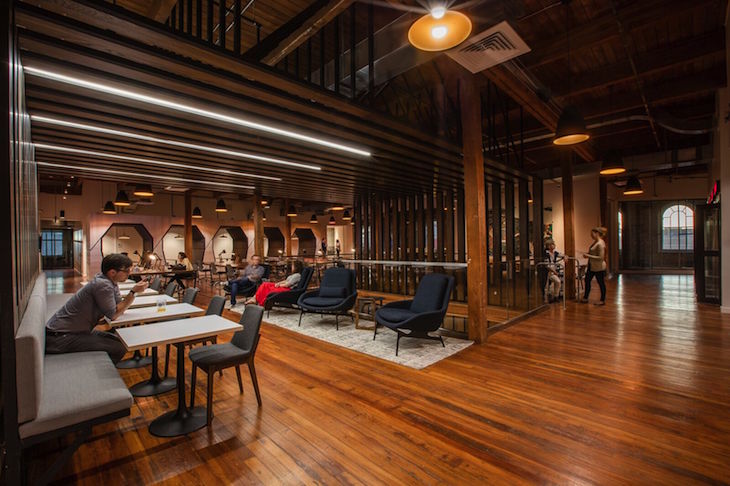A co-working space finds a home in New Orleans’ Contemporary Arts Center.
The Shop is a comprehensive co-working development located in the Contemporary Arts Center (CAC) in downtown New Orleans, designed by Eskew+Dumez+Ripple. Spreading out over the CAC’s third and fourth floors of the former 1920s warehouse, The Shop features over 40,000-square-feet of co-working space for a diverse group of creative professionals across a wide range of industries. The workspace includes 69 fully-furnished offices, seven conference rooms equipped with the latest technology, but the heart of the space is 15,000-square-feet of art-filled commons amenity space, which aims at offering connection and community.

How much space?
37,000 SF Net
What is average daily population?
The Shop currently has around 220 members, not counting employees.
Describe workspace types.
Hot desks, open space, closed private offices, private offices, open offices, coworking space.
What kind of meeting spaces are provided?
Several large and small meeting rooms, as well as open public space
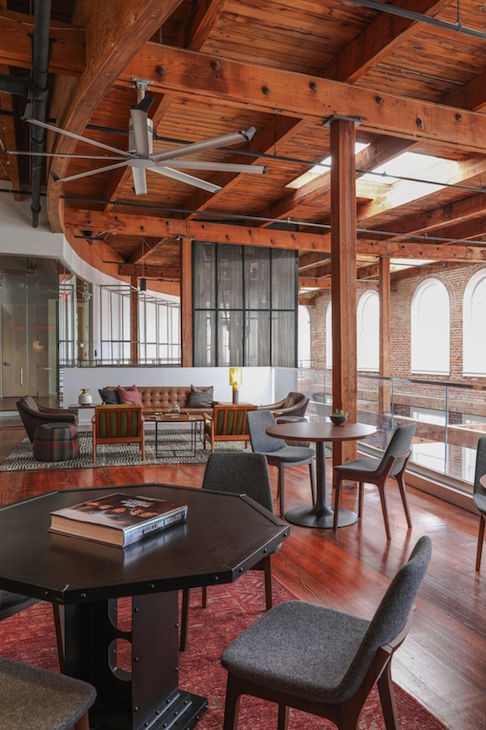
What other kind of support space or amenity spaces are provided?
Commons area, diverse meeting and office space, a rooftop deck, a full kitchen, coffee station, bar, snacks available for purchase, hi-speed WIFI.
What is the project’s location and proximity to public transportation and/or other amenities?
The Shop has a “Walker’s Paradise” score, however access to public transportation is also right outside. There is also immediate access to a Blue Bikes Hub (bike shared program) and the nearby streetcar.
What kind of programming or visioning activities were used?
Various moodboarding and other visioning activities were undertaken with the client to provide a space that would be welcoming and warm. Other coworking models were reviewed, and ultimately a design envisioned that held a primary goal at front of mind: to become a catalyst for New Orleans entrepreneurial community.
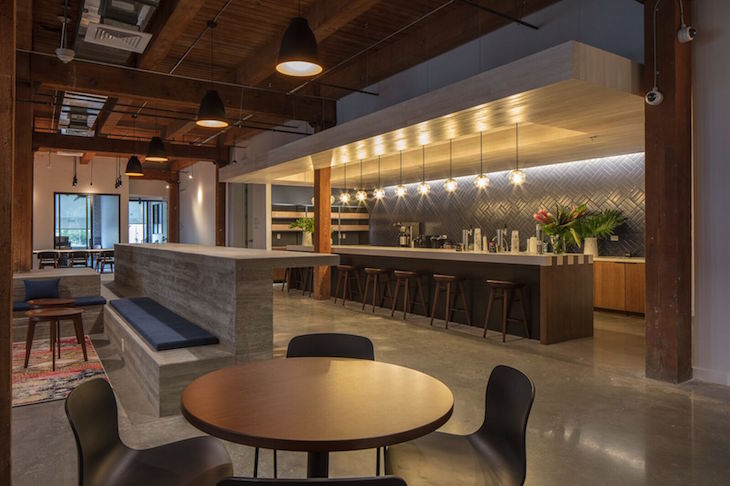
Please describe any program requirements that were unique or required any special research or design requirements.
Located in a historic former warehouse now hosting one of New Orleans’s most important cultural institutions, special care was made to preserve the classic Warehouse District architecture of the existing building while incorporating modern elements. The light-filled space features high ceilings with exposed beams, large windows, a contemporary art collection, and a flowing open floor plan. The heart of The Shop is the commons area designed to facilitate conversation and connection. It boasts a full kitchen, seating options, coffee station, snacks available for purchase, and communal and recreational space. The Shop’s amenities have been designed to offer small businesses, entrepreneurs, and arts-based professionals the resources they need to grow.
Exposing and enhancing the existing conditions was used a unifying element for the entire project. The Shop fronts the atrium of the CAC, with both organizations using the same lobby space to enter from Camp Street. The upper floors, which represented the majority of the atrium, were concealed. By eliminating solid walls and introducing glass as much as possible, daylight was maximized through the entire building. The existing balconies were underutilized. Extending the program to the atrium, the main balcony is intended to be a game room, study, and library. Smaller balconies are attached to larger tenant offices as an amenity space.
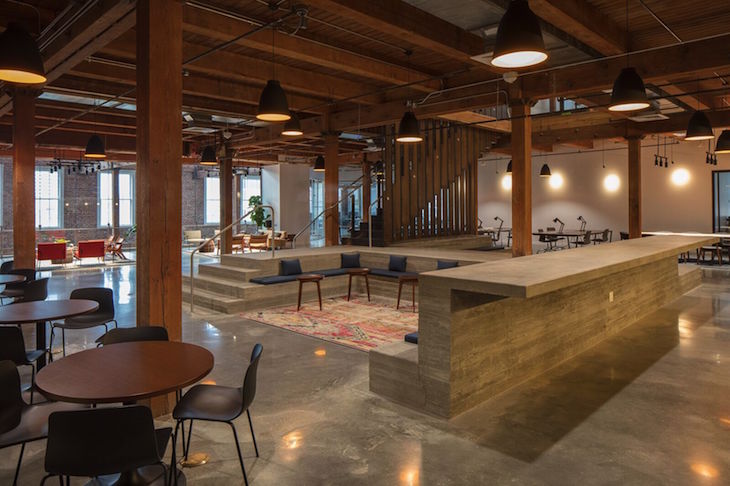
Tell us about any sustainable design initiatives.
The Shop has a number of sustainable design initiatives outside of traditional certification. The progressive aspect of the co-working environment is also reflected in the project’s approach to sustainable design. The careful program organization allows for natural light to enter deep into the space and the project achieves outside views to 80% of occupiable spaces, a particular challenge considering the existing deep floor plans.
Single pane windows on the South and West facades of the Contemporary Arts Center building were replaced with insulated Low-E glass to reduce heat gain and air infiltration. The architectural lighting is LED, which cuts energy consumption by over 80% and lasts up to 25% longer when compared to conventional light bulbs. Occupancy sensors throughout the space turn lights on and of automatically.
Skylights were upgraded to maintain existing daylighting and high-performing insulation was added to the roof and a new high-albedo roof was installed to reflect light, allowing it to stay up to 50-60 degrees cooler than conventional materials during peak heat. The design includes sub-mattering to track energy consumption throughout the year, new low-flow water fixtures targeting a water use reduction of 50% and the project reused existing and found material like steel and fire-glass and repurposed them as new interior storefronts.

Was there any emphasis or requirements on programming for health and wellbeing initiatives for employees?
Yes. Research conducted by organizational psychologist Craig Knight was consulted, which concludes that “empowered offices” – in which workers can choose their conditions – can increase productivity on cognitive tasks by 25 percent or more. The Shop provides this advantage with its innovative design and open commons area, a relaxed atmosphere, and opportunities for relationship building, one of the client’s primary goals.
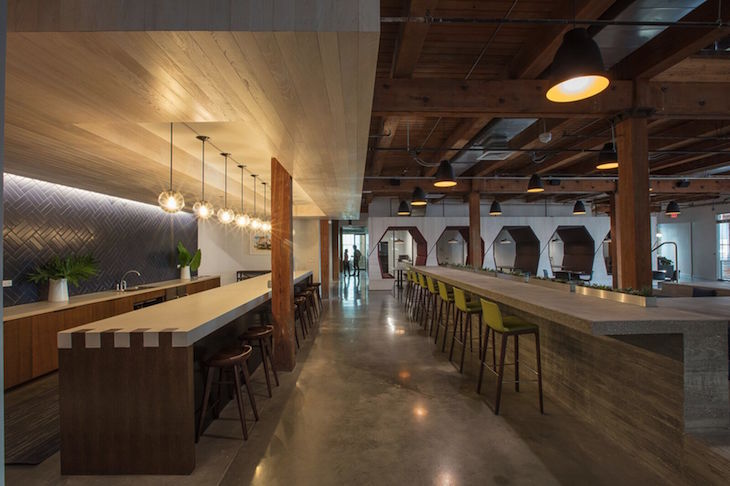
What products or service solutions are making the biggest impact in your space?
- DIRTT
- Spacesaver
- Knoll: Saarinen Executive Arm Chair, Saarinen Side Table, Saarinen Coffee Table, Womb Chair, Bertoia Barstool, Bertoia Diamond Chair, Tulip Arm Chair, Platner Lounge Chair, Florence Knoll Table Desk
- Muuto
- Alias
- Coalesse
- Davis
- KI
- Nucraft
- FilzFelt
What was the hard cost PSF/construction?
$240 / SF
What is the most unique feature of the new space?
While the heart of The Shop is the open commons area, the two floors are connected by an open architectural staircase. The concept emerged from the idea of art and handmade elements intertwined. A variety of work areas are scattered throughout. The concrete base provides informal seating. The stairs weave upwards to form a trellis on the 4th floor, creating a visual link between the two levels.

What kind of technology products were used?
Siemens energy management or building automation system
Tell us more!
- Architect of Record: Eskew+Dumez+Ripple
- MEP Engineer: YKM Consulting, LLC
- Structural Engineer: PACE Group, LLC
- Civil Engineer: PACE Group, LLC
- General Contractor: Palmisano Contractors
- Interior Designer (Art Curation): Studio Interior Design
